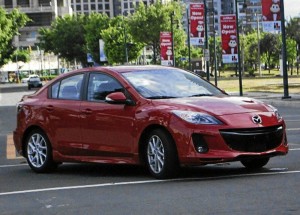It took nine long years, but finally the second-generation Mazda3 is here, restyled but retaining some features from the original 2003 model. Launched on the Philippine market in 2004, the Mazda3 has sold two million units worldwide since its debut in October 2003 and they constitute over one-third of the annual global sales of the line-up of Mazda, Japan’s fifth-largest car maker by volume.
From Day One, the Mazda3 was successfully projected and marketed as a sporty, fun-to-drive “Zoom-Zoom-Zoom” compact car, whether in 4-door sedan or 5-door hatchback configuration, whether powered by a 1.6-liter or 2.0-liter DOHC in-line 4-cylinder 16-valve engine. The selling point was that it’s more fun to drive a Mazda3 than any other mass-production compact car. The 2012 Mazda3 carries on that sales pitch and sharpens that image by coming up with some things old, some things new.
What’s new
Although the Mazda3 has not undergone a stem-to-stern redesign like the Hyundai Elantra or Ford Focus, its exterior has been refreshed with a new mesh grille lowered to front-bumper level, projector-type headlights (bi-xenon in the 2.0L sedan) and bigger openings at either side of the front bumper. At the rear of the sedan, the taillights are narrower and the bumper is bulkier. The result of these changes is a more dynamic, athletic and mature look.
Mazda claims that the front-bumper beam has been subtly reshaped to reduce the turbulence of air passing through the grille and that several speed flaps located at the radiator shroud automatically open at highway speeds to allow some air to bypass the cooling fan. Aerodynamic performance, fuel economy and handling stability have been improved via front-tire deflectors and aero undercarriage treatments.
In the cabin, the coloring and trim of switches and controls surrounding the instrument panel have been changed to silver to minimize the amount of eye movement required to locate them, ensuring smooth operation, greater safety and less fatigue for the driver.
The old Mazda3’s dated red instruments have been replaced with easier-to-read white that is less prone to wash out in sunlight and that provides the driver with information while minimizing eye movement and distraction from the road.
Aside from dual front SRS airbags, all the new Mazda3 variants have curtain and side airbags. The 2.0-liter 3 sports new 10-spoke aluminum wheels, but they are still 17-inch rims. The front wipers are now automatically time-adjustable with rain sensors.
What’s carried over
The engines and transmissions of the old model have been carried over: the 2.0-liter sedan (P1.299 million) with 5-speed Activematic transmission and paddle shifters delivers 145 hp/6,500 rpm and 182 Nm/4,500 rpm max torque. The 1.6 liter hatchback (P1.099 million) and 1.6-liter sedan (P999,000) with 4-speed Activematic gearbox each produce 103 hp/6,000 rpm and 144 Nm/4,000 rpm.
If those retail prices seem steep, it’s because the new 3 is imported CBU [completely built unit] from Japan, while the old 3 is assembled in the Ford plant here (Ford Group PH still holds a stake in Mazda), along with the 2012 Ford Focus, production of the new Mazda 3 will be transferred this year from the Philippines to Thailand, which is logical since the Focus and the 3 share the same chassis.
Although the old 3’s suspension system has been retained: front MacPherson strut and multi-link geometry in the back—it has been enhanced to remain composed under hard braking and cornering.
THE NEW Mazda3 is still more nimble and fun to drive, offers a refined, comfy ride, presents a stylish new look and is extremely well kitted with an outstanding suite of safety features.
The steering wheel of the 2.0-liter sedan has paddle shifters, audio control and cruise control switches as the audio system, like before, includes a 6-disc CD changer (MP3) with 6 speakers and AM/FM radio. In the 1.6 variants, the CD player is single-disc. Automatic aircon control and leather seats in the 2.0 sedan, manual aircon and cloth-trim seats in the 1.6 variants, disc brakes on all four wheels in both the 2.0 and 1.6 models, ditto auxiliary port, height-adjustable driver’s seat, adjustable headrests on front and rear seats with rear seat splitting 60/40 and folding flat to increase luggage space.
The safety features, in all variants, aside from six airbags, include ABS with EBD and brake assist, 3-point seatbelts with pretensioners and load limiters, engine immobilizer, burglar alarm system. The 1.6 variants have a retractable key while the 2.0-liter sedan has a smart key with start-stop push button on the dash.
No Skyactiv technology yet
If you’re wondering why the new Mazda3 sold here has a 4-speed or 5-speed automatic transmission instead of a 6-speed, it’s because the models available locally do not have Skyactive technology, which includes a 6-speed gearbox and which is found in the newly introduced Mazda compact SUV, the CX-5. According to Mazda PH, only the United States and European Union markets offer the Skyactiv Mazda3, but these only have the Skyactiv G engine and 6-speed manual or automatic transmission, not the Skyactive body. Only the CX-5 has it all: Skyactiv body (lightweight chassis and improved aerodynamics,) engine ((155 hp, 148 pound-feet max torque, 14:01 compression ratio) and 6-speed tranny resulting in average mileage of 12 km/liter in town and 17 km/liter on the highway.
Nonetheless, the new Mazda3 with the original engine and Activematic gearbox is still more nimble and fun to drive, offers a refined, comfy ride, presents a stylish new look and is extremely well kitted with an outstanding suite of safety features.
